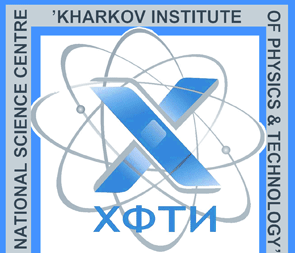
NSC KIPT / Institute of Solid State Physics Materials and Technology
DEPARTEMENT OF PURE METALS, PHYSICS OF METALS AND TECHNOLOGY OF NEW MATERIALS
SCIENTIFIC-RESEARCHING LABORATORY OF ELECTROPHYSICAL MATERIALS
AND TECHNICAL SUPERCONDUCTORS
MAIN RESULTS
-
Technological processes for production of reactor steels modified by nanoparticles of thermal stable oxides (ODS steels) are developed. In the temperature range 20-700oC strength characteristics of developed austenitic ODS steel are 2-3,5 times higher and swelling is 5 times lower than that of the base steel 18Cr10NiTi [4]. Such steels are promising for production of pressure vessel internals for reactors of new generations.
-
Nanocrystalline zirconium and titanium of different degree of purity and also nanostructurized alloys on their base are developed and investigated [5-12]. For the first time [7-10, 12] is used combination of two methods of extreme effects on metals – intense plastic deformation plus subsequent cryogenic deformation (jointly with the department of solid state physics and condensed state).In the result of such effect grain structure with grain size lower 100 nm is realized in titanium and zirconium. Strength characteristics have increased with the preservation of satisfactory plasticity. For example in iodide titanium with the mean size of the grain 75 nm the ultimate strength is equal approximately to 930 MPa and elongation to rupture ≈12%. In technical titanium VT1-0 with the grain size 65 nm these characteristics are 1220 MPa and 8%, respectively which is on the level of mean- alloyed titanium alloys. These materials are prospective also for production of medical implants due to the absence of toxic elements and higher osteo synthesis.
-
New methods are developed, conditions of mechanical-thermal treatment of deforming superconductors on the base of niobium-titanium alloys are optimized. Processes of decay in metastable Ni-Ti-alloys and influence of different technological and structure factors on their electrophysical characteristics are studied. In the result of such activity superconductors with high current-carrier power are produced including superconductors with record value of critical current Jc (5 T, 4,2 K)=4`105 A/cm2 [3,13-15].
-
Firstly due to the use of developed in the laboratory unique method of high-gradient directed crystallization (HGDC) the deformed bronze with high concentration of tin [2] (16-185 by mass) was obtained also as high-tin bronze alloyed by third element (Ti, Ge and others). On the base of such bronze the multi-wires (14640 wires) Nb3Sn – supercondiuctors with increased current-carrier capacity in strong magnetic fields were produced in industrial conditions. Production of HGDS alloys Cu-Nb-Sn, their subsequent deformation and thermal treatment have allowed also to obtain "natural" (in situ) microcomposite Nb3Sn – superconductors with high values of density of critical current in mean fields (to 8 T), high strength and high values of deformation without degradation of their characteristics [2].
-
A range of works in the area of production and investigation of heavy current high temperature superconductors of oxide type (yttrium and bismuth ceramics) is carried out. The main methods of such superconductors production were directed crystallization and different methods of mechanical-thermal treatment. The obtained superconductors have a high current carrier power.
-
Technology of production of "natural" (in situ" micro- and nano composite materials on the base of two phase copper alloys is developed; the second element in these materials has the low solubility in copper and forms intermetallides (Nb, Cr, Ta). Technology includes melting of ingots and their deep deformation. For alloys copper-niobium influence of different factors (alloy composition, presence of impurities, degree and temperature of deformation, regimes of thermal treatment) on structure and characteristics of composites is studied comprehensively. Developed nanocomposites have a better combination of strength and electrical conductivity (strength reaches 2300 MPa with electrical conductivity 35-40%of electrical conductivity of pure copper). Nanocomposites may be used in different electro technical and electron devices (pulsed cryogenic high-field magnets, strengthening of superconductors on the base of intermetallides, highly loaded elements of electrical machines and electric power lines, current supply of integral circuit and others).
-
Permanent magnets and systems on their base
-
The developed technology of high-gradient directed crystallization is used for production of monocrystalline alloys, in particular of high-temperature strength nickel alloys for blades of gas-turbine engines [18-21]. Jointly with Laboratory of Semiconductor Materials bay for production of monocrystalline seeds for melting of monocrystalline blades was organized. More than 120 000 of high quality seeds are produced of alloy of nickel-tungsten for plants of Ukraine (JSC "Motor Sich", Zaporogye; SE "Scientific-industrial complex of gas-turbine engineering industry "Zorya"-"Mashproject", Nikolaev).
-
The new trends of investigations are high entropy alloys (HEA). HEA on the base of sytems AlCoCrCuFeNi and CoCrFeNi(Mn,V) are produced and studied. The high plasticity of alloys is detected. Investigation of the effect of different treatment on their structure and properties are in progress. Alloys are also interesting due to their high radiation resistance.
-
Improved constructions are developed, production of high-temperature (with operational temperature 300-350oC) vibration detectors and detector of acoustic emission [22]. Detectors are used for the control of operation of different assemblies and systems on Zaporogskaya nuclear power station and also on oil and gas pumping stations.
|
|
